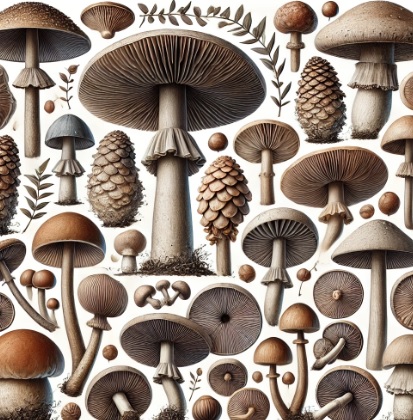The Agaricaceae family, within the order Agaricales, consists of a wide variety of fungi, including some of the most common mushrooms that are found in forests, grasslands, and other habitats worldwide. This family includes genera such as Agaricus, Armillaria, and Coprinus, many of which are edible, while others have medicinal properties or contribute to ecological processes. The most famous species in this family is Agaricus bisporus, commonly known as the white button mushroom, which is widely cultivated for food.
General Description
Fungi in the Agaricaceae family exhibit several common features:
- Cap: The caps of mushrooms in this family are typically smooth or slightly scaly and are usually convex or flat. They can range in size from small to large and are often brightly colored, including shades of white, brown, red, and yellow.
- Gills: The gills are typically free or slightly attached to the stem and are crowded. They can be white, pink, brown, or black depending on the species, and they darken with age as the spores mature.
- Stem: The stem is typically central, cylindrical, and fibrous. In some species, the stem may have a ring (annulus) near the top or a volva (a cup-like structure at the base).
- Spores: The spores are released from the gills and are typically white to brown or black, depending on the species.
Chemical Composition
The fungi in the Agaricaceae family produce various bioactive compounds, some of which are important for their medicinal properties:
- Psilocybin and Psilocin: Certain species in the Agaricaceae family, such as those in the Psilocybe genus, contain psilocybin and psilocin, which are hallucinogenic compounds used in certain cultural and spiritual practices.
- Triterpenes and Sterols: Some species in this family, like those in the Armillaria genus, produce triterpenes and sterols, which have antimicrobial and anti-inflammatory properties.
- Polysaccharides: Several species in the Agaricaceae family, including Agaricus bisporus (the white button mushroom), contain polysaccharides that are believed to boost the immune system and may have anti-cancer properties.
- Alkaloids: Some species, particularly in the Coprinus genus, contain alkaloids, which have varying effects, including medicinal properties and potential toxicity.
Physical Properties
The physical characteristics of mushrooms in the Agaricaceae family include:
- Cap: The cap is typically convex or bell-shaped when young, flattening out with age. The surface may be smooth or slightly scaly, with colors that range from white to brown, and some species have bright colors, such as red or yellow.
- Gills: Gills are usually free from the cap and may darken with age. Initially, they can be white, pink, or pale, changing to darker colors as the spores mature.
- Stem: The stem is often fibrous, cylindrical, and central, and in some species, it has a ring or a cup-like structure at the base.
- Spores: The spores are released from the gills and range in color from white to brown or black, depending on the species.
Ecological Role
Fungi in the Agaricaceae family play important ecological roles:
- Decomposers: Many species, such as those in the Armillaria genus, are saprophytic, meaning they decompose dead organic matter, including wood and plant debris. This process is vital for nutrient cycling and helps maintain ecosystem health.
- Symbiosis: Some species in this family form mycorrhizal relationships with plants, helping plants acquire nutrients from the soil in exchange for carbohydrates.
Medicinal and Culinary Applications
- Agaricus bisporus (Agaricus bisporus): This species, commonly known as the white button mushroom, is one of the most widely consumed mushrooms worldwide. It is a rich source of vitamins, minerals, and antioxidants and is known for its immune-boosting properties.
- Psilocybin Mushrooms (Psilocybe species): Species like Psilocybe cubensis contain the hallucinogenic compounds psilocybin and psilocin, which are used for their psychoactive effects in certain cultural practices. Recent studies have also investigated their potential therapeutic use for treating mental health conditions, including depression, PTSD, and anxiety.
- Medicinal Mushrooms (Armillaria species): Some species of Armillaria, such as Armillaria mellea, are used in traditional medicine for their purported immune-enhancing and anti-inflammatory effects. Research is ongoing to investigate their potential medicinal properties.
Environmental and Safety Considerations
- Toxicity: While many mushrooms in the Agaricaceae family are edible, some species, such as Coprinus and Psilocybe, can be toxic or cause adverse effects if consumed improperly. For example, certain Coprinus species cause a reaction when consumed with alcohol. Additionally, Psilocybe species can induce hallucinogenic effects, which may lead to psychological discomfort or harm if not used responsibly.
- Sustainability: Many species in the Agaricaceae family are cultivated commercially, especially Agaricus bisporus, but wild mushrooms should be foraged with care. Overharvesting or improper identification can pose risks, and some species are endangered or protected.
INCI Functions
- Antioxidant: Protects the skin from oxidative stress and damage.
- Anti-inflammatory: Reduces inflammation and soothes the skin.
- Antimicrobial: Helps combat harmful microorganisms on the skin.
- Immune-boosting: Promotes immune function and supports overall health.
Conclusion
The Agaricaceae family is a diverse group of fungi, with species that play essential roles in ecosystems, offer culinary and medicinal benefits, and produce various bioactive compounds. Agaricus bisporus is widely cultivated for food and is known for its nutritional and immune-boosting properties, while species like Psilocybe cubensis are studied for their psychoactive and potential therapeutic effects.
![]() Agaricaceae
Agaricaceae 

